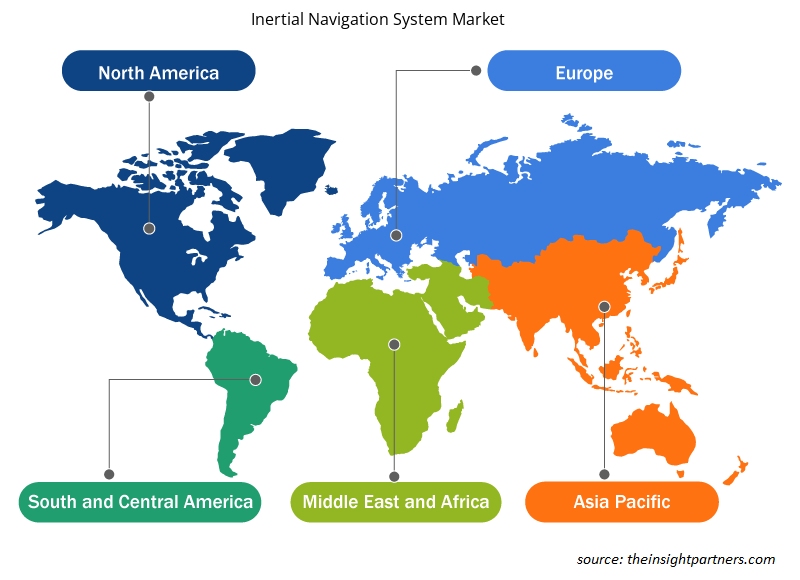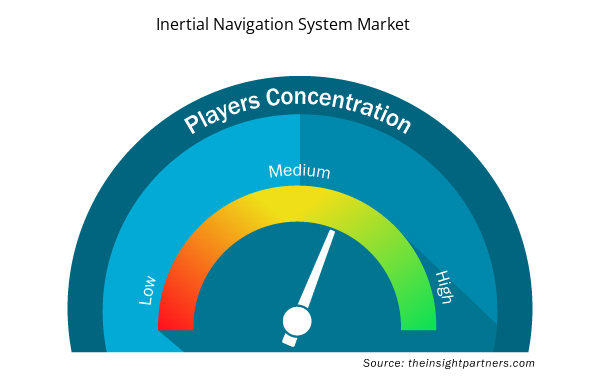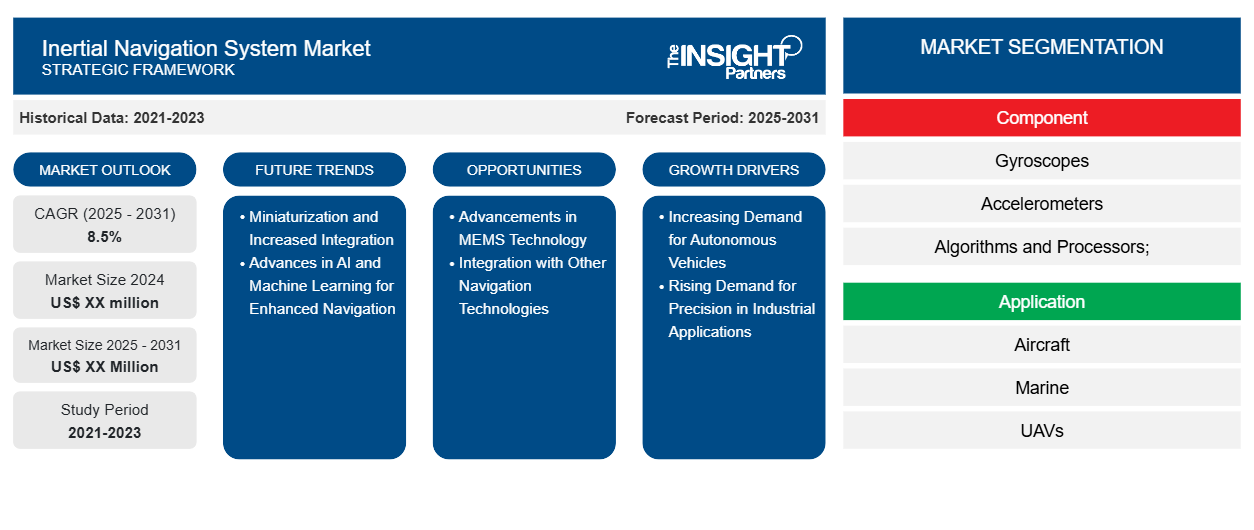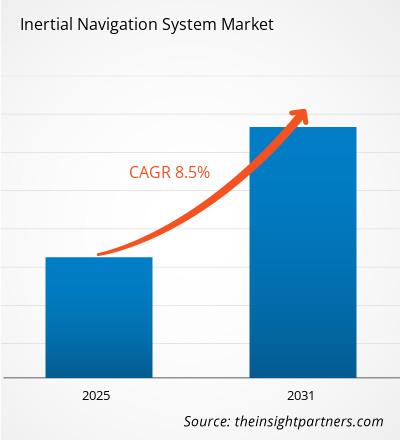Se espera que el mercado de sistemas de navegación inercial registre una CAGR del 8,5 % entre 2023 y 2031, con un tamaño de mercado que se expandirá de US$ XX millones en 2023 a US$ XX millones en 2031.
El mercado de sistemas de navegación inercial cubre el análisis por componente (giroscopios, acelerómetros, algoritmos y procesadores); aplicación (aeronaves, marina, vehículos aéreos no tripulados, otros); tecnología (giroscopio mecánico, MEMS, giroscopio de fibra óptica, otros) y geografía (América del Norte, Europa, Asia Pacífico, Oriente Medio y África, y América del Sur y Central)
Propósito del Informe
El informe Inertial Navigation System Market de The Insight Partners tiene como objetivo describir el panorama actual y el crecimiento futuro, los principales factores impulsores, los desafíos y las oportunidades. Esto proporcionará información a diversas partes interesadas del negocio, como:
- Proveedores/fabricantes de tecnología: Para comprender la dinámica cambiante del mercado y conocer las oportunidades potenciales de crecimiento, lo que les permitirá tomar decisiones estratégicas informadas.
- Inversionistas: Realizar un análisis exhaustivo de tendencias sobre la tasa de crecimiento del mercado, las proyecciones financieras del mercado y las oportunidades que existen en toda la cadena de valor.
- Órganos reguladores: Regular las políticas y vigilar las actividades del mercado con el objetivo de minimizar los abusos, preservar la confianza de los inversores y defender la integridad y estabilidad del mercado.
Segmentación del mercado de sistemas de navegación inercial
Componente
- Giroscopios
- Acelerómetros
- Algoritmos y procesadores;
Solicitud
- Aeronave
- Marina
- Vehículos aéreos no tripulados (UAV)
- Otros;
Tecnología
- Giroscopio mecánico
- MEMS
- Giroscopio de fibra óptica
- Otros
Geografía
- América del norte
- Europa
- Asia-Pacífico
- América del Sur y Central
- Oriente Medio y África
Geografía
- América del norte
- Europa
- Asia-Pacífico
- América del Sur y Central
- Oriente Medio y África
Personalice este informe según sus necesidades
Obtendrá personalización en cualquier informe, sin cargo, incluidas partes de este informe o análisis a nivel de país, paquete de datos de Excel, así como también grandes ofertas y descuentos para empresas emergentes y universidades.
- Obtenga las principales tendencias clave del mercado de este informe.Esta muestra GRATUITA incluirá análisis de datos, desde tendencias del mercado hasta estimaciones y pronósticos.
Factores impulsores del crecimiento del mercado de sistemas de navegación inercial
- Demanda creciente de vehículos autónomos: uno de los principales impulsores del mercado de sistemas de navegación inercial (INS) es la creciente demanda de vehículos autónomos, incluidos drones, vehículos aéreos no tripulados (UAV) y vehículos terrestres autónomos. La tecnología INS es fundamental para estos sistemas porque proporciona datos precisos de posición, velocidad y orientación sin necesidad de señales externas como el GPS. A medida que los vehículos autónomos siguen siendo adoptados ampliamente en sectores como el transporte, la logística y la defensa, se espera que aumente significativamente la necesidad de sistemas INS de alto rendimiento que puedan funcionar en entornos sin GPS.
- Demanda creciente de precisión en aplicaciones industriales: la necesidad de alta precisión en aplicaciones industriales, como robótica, topografía y exploración geofísica, está impulsando la adopción de sistemas de navegación inercial. En industrias como la minería, el petróleo y el gas, y la construcción, el seguimiento preciso de equipos y personal es fundamental. Los INS pueden proporcionar datos precisos sobre el posicionamiento y los movimientos de los equipos, lo que garantiza la seguridad y la eficiencia en estos entornos de alto riesgo. A medida que estas industrias sigan creciendo y requieran sistemas de navegación más sofisticados, aumentará la demanda de soluciones INS.
Tendencias futuras del mercado de sistemas de navegación inercial
- Miniaturización y mayor integración: una tendencia clave en el mercado de sistemas de navegación inercial es la miniaturización de sensores y la mayor integración de componentes INS. A medida que aumenta la demanda de sistemas de navegación más pequeños, livianos y rentables, la industria avanza hacia el desarrollo de sistemas altamente integrados que combinan múltiples sensores y componentes en un solo paquete. Esta miniaturización beneficiará a sectores como la electrónica de consumo, donde las limitaciones de espacio y peso son críticas, así como a las aplicaciones emergentes en el mercado de IoT y dispositivos portátiles. La tendencia hacia sistemas más pequeños y potentes también impulsará el crecimiento en otros sectores, como los dispositivos médicos y la robótica portátil.
- Avances en IA y aprendizaje automático para mejorar la navegación: la aplicación de inteligencia artificial (IA) y aprendizaje automático (ML) a los sistemas de navegación inercial es una tendencia emergente. Los algoritmos de IA y ML se pueden utilizar para mejorar la precisión y la confiabilidad de los INS al procesar grandes cantidades de datos en tiempo real, corregir errores y mejorar el rendimiento en entornos desafiantes. Por ejemplo, en vehículos autónomos y drones, la IA y el ML pueden ayudar a predecir y ajustar los cambios en el entorno, como obstáculos o cambios en el terreno, mejorando la navegación incluso en condiciones dinámicas o sin GPS. La convergencia de la IA con la tecnología INS mejorará significativamente las capacidades de los sistemas de navegación en varias industrias.
Oportunidades de mercado para sistemas de navegación inercial
- Avances en la tecnología MEMS: la tecnología de sistemas microelectromecánicos (MEMS) ha hecho avanzar significativamente el desarrollo de sensores inerciales más pequeños, más ligeros y más rentables. Los sistemas de navegación inercial basados en MEMS son cada vez más populares debido a su menor coste, tamaño compacto y capacidad para ofrecer un rendimiento fiable en una amplia gama de aplicaciones. Esto presenta una oportunidad para que el mercado de INS se expanda a los sectores comerciales y de consumo, incluidos los teléfonos inteligentes, los dispositivos portátiles y los sistemas de navegación personal. El desarrollo de sistemas basados en MEMS abre nuevos mercados, en particular para las industrias que requieren soluciones de navegación compactas y asequibles.
- Integración con otras tecnologías de navegación: el futuro de los sistemas de navegación inercial radica en su integración con otras tecnologías de navegación, como el GPS, la odometría visual y la localización y cartografía simultáneas (SLAM). Al combinar el INS con estas tecnologías, los sistemas pueden proporcionar una mayor precisión, fiabilidad y resiliencia en entornos complejos y dinámicos. Por ejemplo, la integración del INS con el GPS y los sistemas basados en visión puede mejorar la navegación de los drones y los vehículos autónomos en entornos urbanos donde las señales del GPS pueden ser débiles u obstruidas. Este enfoque integrado es especialmente valioso en sectores como el transporte autónomo, la robótica y la agricultura, donde la navegación precisa es esencial.
Perspectivas regionales del mercado de sistemas de navegación inercial
Los analistas de Insight Partners explicaron en detalle las tendencias y los factores regionales que influyen en el mercado de sistemas de navegación inercial durante el período de pronóstico. Esta sección también analiza los segmentos y la geografía del mercado de sistemas de navegación inercial en América del Norte, Europa, Asia Pacífico, Oriente Medio y África, y América del Sur y Central.

- Obtenga datos regionales específicos para el mercado de sistemas de navegación inercial
Alcance del informe de mercado del sistema de navegación inercial
| Atributo del informe | Detalles |
|---|---|
| Tamaño del mercado en 2023 | XX millones de dólares estadounidenses |
| Tamaño del mercado en 2031 | US$ XX millones |
| CAGR global (2023 - 2031) | 8,5% |
| Datos históricos | 2021-2022 |
| Período de pronóstico | 2024-2031 |
| Segmentos cubiertos | Por componente
|
| Regiones y países cubiertos | América del norte
|
| Líderes del mercado y perfiles de empresas clave |
|
Densidad de actores del mercado de sistemas de navegación inercial: comprensión de su impacto en la dinámica empresarial
El mercado de sistemas de navegación inercial está creciendo rápidamente, impulsado por la creciente demanda de los usuarios finales debido a factores como la evolución de las preferencias de los consumidores, los avances tecnológicos y una mayor conciencia de los beneficios del producto. A medida que aumenta la demanda, las empresas amplían sus ofertas, innovan para satisfacer las necesidades de los consumidores y aprovechan las tendencias emergentes, lo que impulsa aún más el crecimiento del mercado.
La densidad de actores del mercado se refiere a la distribución de las empresas o firmas que operan dentro de un mercado o industria en particular. Indica cuántos competidores (actores del mercado) están presentes en un espacio de mercado determinado en relación con su tamaño o valor total de mercado.
Las principales empresas que operan en el mercado de sistemas de navegación inercial son:
- Aeroespacial Collins
- Compañía General Electric
- Compañía: Honeywell International Inc.
- Señor MicroStrain
- Corporación Northrop Grumman
Descargo de responsabilidad : Las empresas enumeradas anteriormente no están clasificadas en ningún orden particular.

- Obtenga una descripción general de los principales actores clave del mercado de sistemas de navegación inercial
Puntos de venta clave
- Cobertura integral: el informe cubre de manera integral el análisis de productos, servicios, tipos y usuarios finales del mercado de sistemas de navegación inercial, proporcionando un panorama holístico.
- Análisis de expertos: el informe se compila sobre la base de un profundo conocimiento de expertos y analistas de la industria.
- Información actualizada: El informe asegura relevancia comercial debido a su cobertura de información reciente y tendencias de datos.
- Opciones de personalización: este informe se puede personalizar para satisfacer los requisitos específicos del cliente y adaptarse adecuadamente a las estrategias comerciales.
Por lo tanto, el informe de investigación sobre el mercado de sistemas de navegación inercial puede ayudar a abrir camino para descifrar y comprender el escenario de la industria y las perspectivas de crecimiento. Si bien puede haber algunas preocupaciones válidas, los beneficios generales de este informe tienden a superar las desventajas.
- Análisis histórico (2 años), año base, pronóstico (7 años) con CAGR
- Análisis PEST y FODA
- Tamaño del mercado Valor/volumen: global, regional, nacional
- Industria y panorama competitivo
- Conjunto de datos de Excel


- Virtual Event Software Market
- Personality Assessment Solution Market
- Microcatheters Market
- Third Party Logistics Market
- Biopharmaceutical Tubing Market
- Micro-Surgical Robot Market
- Excimer & Femtosecond Ophthalmic Lasers Market
- Vision Care Market
- Industrial Inkjet Printers Market
- Identity Verification Market

Report Coverage
Revenue forecast, Company Analysis, Industry landscape, Growth factors, and Trends

Segment Covered
This text is related
to segments covered.

Regional Scope
North America, Europe, Asia Pacific, Middle East & Africa, South & Central America

Country Scope
This text is related
to country scope.
Preguntas frecuentes
Some of the customization options available based on the request are an additional 3-5 company profiles and country-specific analysis of 3-5 countries of your choice. Customizations are to be requested/discussed before making final order confirmation, as our team would review the same and check the feasibility.
The report can be delivered in PDF/PPT format; we can also share excel dataset based on the request.
The major players in the market includes Northrop Grumman, Honeywell International, Safran, General Electric, Thales Group, Raytheon Technologies, Teledyne Technologies, Parker-Hannifin Corporation, Gladiator Technologies, Trimble Navigation, and others.
High manufacturing cost of the inertial navigation sysetm hinders the market growth.
The Inertial Navigation System Market is estimated to witness a CAGR of 8.5% from 2023 to 2031
Rising government spending on military navigation system 'across the globe driving the market growth
Trends and growth analysis reports related to Aerospace and Defense : READ MORE..
1. Collins Aerospace2. General Electric Company3. Honeywell International Inc.4. LORD MicroStrain5. Northrop Grumman Corporation6. Safran Electronics and Defense7. Teledyne TSS8. Thales Group9. The Raytheon Company10. Trimble Navigation Ltd.
The Insight Partners performs research in 4 major stages: Data Collection & Secondary Research, Primary Research, Data Analysis and Data Triangulation & Final Review.
- Data Collection and Secondary Research:
As a market research and consulting firm operating from a decade, we have published and advised several client across the globe. First step for any study will start with an assessment of currently available data and insights from existing reports. Further, historical and current market information is collected from Investor Presentations, Annual Reports, SEC Filings, etc., and other information related to company’s performance and market positioning are gathered from Paid Databases (Factiva, Hoovers, and Reuters) and various other publications available in public domain.
Several associations trade associates, technical forums, institutes, societies and organization are accessed to gain technical as well as market related insights through their publications such as research papers, blogs and press releases related to the studies are referred to get cues about the market. Further, white papers, journals, magazines, and other news articles published in last 3 years are scrutinized and analyzed to understand the current market trends.
- Primary Research:
The primarily interview analysis comprise of data obtained from industry participants interview and answers to survey questions gathered by in-house primary team.
For primary research, interviews are conducted with industry experts/CEOs/Marketing Managers/VPs/Subject Matter Experts from both demand and supply side to get a 360-degree view of the market. The primary team conducts several interviews based on the complexity of the markets to understand the various market trends and dynamics which makes research more credible and precise.
A typical research interview fulfils the following functions:
- Provides first-hand information on the market size, market trends, growth trends, competitive landscape, and outlook
- Validates and strengthens in-house secondary research findings
- Develops the analysis team’s expertise and market understanding
Primary research involves email interactions and telephone interviews for each market, category, segment, and sub-segment across geographies. The participants who typically take part in such a process include, but are not limited to:
- Industry participants: VPs, business development managers, market intelligence managers and national sales managers
- Outside experts: Valuation experts, research analysts and key opinion leaders specializing in the electronics and semiconductor industry.
Below is the breakup of our primary respondents by company, designation, and region:

Once we receive the confirmation from primary research sources or primary respondents, we finalize the base year market estimation and forecast the data as per the macroeconomic and microeconomic factors assessed during data collection.
- Data Analysis:
Once data is validated through both secondary as well as primary respondents, we finalize the market estimations by hypothesis formulation and factor analysis at regional and country level.
- Macro-Economic Factor Analysis:
We analyse macroeconomic indicators such the gross domestic product (GDP), increase in the demand for goods and services across industries, technological advancement, regional economic growth, governmental policies, the influence of COVID-19, PEST analysis, and other aspects. This analysis aids in setting benchmarks for various nations/regions and approximating market splits. Additionally, the general trend of the aforementioned components aid in determining the market's development possibilities.
- Country Level Data:
Various factors that are especially aligned to the country are taken into account to determine the market size for a certain area and country, including the presence of vendors, such as headquarters and offices, the country's GDP, demand patterns, and industry growth. To comprehend the market dynamics for the nation, a number of growth variables, inhibitors, application areas, and current market trends are researched. The aforementioned elements aid in determining the country's overall market's growth potential.
- Company Profile:
The “Table of Contents” is formulated by listing and analyzing more than 25 - 30 companies operating in the market ecosystem across geographies. However, we profile only 10 companies as a standard practice in our syndicate reports. These 10 companies comprise leading, emerging, and regional players. Nonetheless, our analysis is not restricted to the 10 listed companies, we also analyze other companies present in the market to develop a holistic view and understand the prevailing trends. The “Company Profiles” section in the report covers key facts, business description, products & services, financial information, SWOT analysis, and key developments. The financial information presented is extracted from the annual reports and official documents of the publicly listed companies. Upon collecting the information for the sections of respective companies, we verify them via various primary sources and then compile the data in respective company profiles. The company level information helps us in deriving the base number as well as in forecasting the market size.
- Developing Base Number:
Aggregation of sales statistics (2020-2022) and macro-economic factor, and other secondary and primary research insights are utilized to arrive at base number and related market shares for 2022. The data gaps are identified in this step and relevant market data is analyzed, collected from paid primary interviews or databases. On finalizing the base year market size, forecasts are developed on the basis of macro-economic, industry and market growth factors and company level analysis.
- Data Triangulation and Final Review:
The market findings and base year market size calculations are validated from supply as well as demand side. Demand side validations are based on macro-economic factor analysis and benchmarks for respective regions and countries. In case of supply side validations, revenues of major companies are estimated (in case not available) based on industry benchmark, approximate number of employees, product portfolio, and primary interviews revenues are gathered. Further revenue from target product/service segment is assessed to avoid overshooting of market statistics. In case of heavy deviations between supply and demand side values, all thes steps are repeated to achieve synchronization.
We follow an iterative model, wherein we share our research findings with Subject Matter Experts (SME’s) and Key Opinion Leaders (KOLs) until consensus view of the market is not formulated – this model negates any drastic deviation in the opinions of experts. Only validated and universally acceptable research findings are quoted in our reports.
We have important check points that we use to validate our research findings – which we call – data triangulation, where we validate the information, we generate from secondary sources with primary interviews and then we re-validate with our internal data bases and Subject matter experts. This comprehensive model enables us to deliver high quality, reliable data in shortest possible time.


 Obtenga una muestra gratuita de este informe
Obtenga una muestra gratuita de este informe